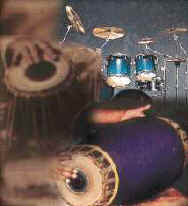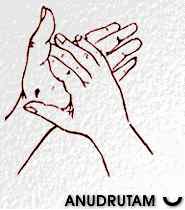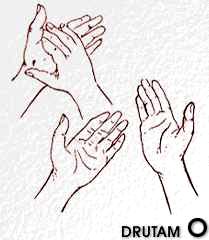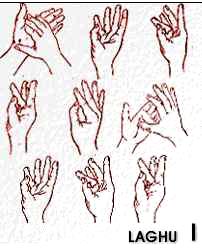|
|
 The
very heart-beat of music is Laya. Rhythm in Carnatic music is accorded a
very high status as is evident from the Sanskrit maxim, "Layah
pita", meaning, Rhythm is the Father. We shall now explore the
different facets of rhythm in Carnatic music. The
very heart-beat of music is Laya. Rhythm in Carnatic music is accorded a
very high status as is evident from the Sanskrit maxim, "Layah
pita", meaning, Rhythm is the Father. We shall now explore the
different facets of rhythm in Carnatic music.
APPRECIATING LAYA
Rhythm is omnipresent. There is rhythm in the movement of heavenly bodies
just as in the life cycles of micro organisms. It is only natural that man
is endowed with it. Whenever we listen to music, we look for the rhythmic
movements in it and then find ourselves tapping our feet or clapping our
hands or even dancing to it. But what exactly do we mean by rhythm? Rhythm
can be defined as a process in which the nuclei of attention are separated
by individual parts of time. Whenever we listen to music, we cannot but
perceive rhythm. Rhythm gives stability and form to music. It can be
described as the tangible gait of any musical movement. In Carnatic music,
this is referred to as Laya. The common fallacy is that rhythm or laya is
confined to percussion instruments and the rhythmic patterns produced
therein. But laya is not limited to just that. It is present not only in
melodic compositions, which usually have a rhythmic metre in an apparent
manner but also in the creative aspects, sometimes conspicuously (like in
Neraval or Kalpanaswara) and subtly at others (Raga alapana and Tanam).
RHYTHMIC ASPECTS
The rhythmic aspects in Carnatic music are arguably among the most
developed and sophisticated across the world. The patterns range from the
simple to the complex. The study of rhythmic aspects involves
understanding the terms Tala and Laya.
Tala and Laya
Tala is often confused with Laya. Laya refers to the inherent rhythm in
anything. Irrespective of whether it is demonstrated or not, it is always
present. This can be better illustrated with an example. We know that the
sun, the planets and other heavenly bodies are moving objects. Even as our
earth rotates on its axis and revolves around the sun, these bodies have
their own fixed movements and speeds. Even a microscopic disturbance in
that speed may lead to disasters of huge proportions. So laya can be
explained as the primordial orderliness of movements. Expression of laya
in an organised fashion through fixed time cycles is known as Tala. Thus
it serves as the structured rhythmic meter to measure musical
time-intervals. Tala in Carnatic music is usually expressed physically by
the musician through accented beats and unaccented finger counts or a wave
of the hand. In other words, Tala is but a mere scale taken for the sake
of convenience.
THE TALA SYSTEM
The soundness of a system, primarily mathematical in character, consists
of its internal coherency, logical rigidity and numeric accuracy. The tala
system in Carnatic music satisfies all these conditions and is not only
perfect but also beautifully elastic.There are six parts (Angas - limbs) of a tala but the following three
are used more frequently than the others:

Anudrutam
- a beat, represented by the symbol "U". This is physically
represented as 1 unit.

Drutam
- a beat and a wave of the hand, represented by the symbol "O".
This is physically represented as 2 units.

Sankeerna
Laghu
Laghu
- a beat followed by finger counts starting from the little finger. It is
represented by the symbol "l". Laghu can be of five types (Jaati)
depending on the number of units:
Chaturasra (Jaati) laghu has a beat plus
3 finger counts, which is a total of 4 units.
Tisra (Jaati) laghu has 3 units i.e. a beat plus 2 finger counts.
Misra (Jaati) laghu has 7 units, i.e. a beat plus six finger counts.
Khanda (Jaati) laghu has 5 units, i.e. a beat plus four finger counts.
Sankeerna (Jaati) laghu has 9 units, i.e. beat plus eight finger
counts.
To render Misra and Sankeerna laghu, one comes back to the little
finger after exhausting the fingers while counting up to 6.
The remaining 3 angas, namely Guru (8 units), Plutam (12 units) and
Kakapadam (16 units) are not frequently used in the talas generally
used in the concerts. These talas find greater use in the ancient tala
system. In the present day context, they figure in thematic programmes or
Pallavi demonstrations.
An example of a tala that uses all the parts mentioned so far is
Simhanandana tala, the longest tala, with 128 units. Talas make the
counting of larger meters (some of them beyond a hundred units) easier.
The audience also gets an opportunity to participate more actively in the
concert when they maintain tala along with the performers.
|